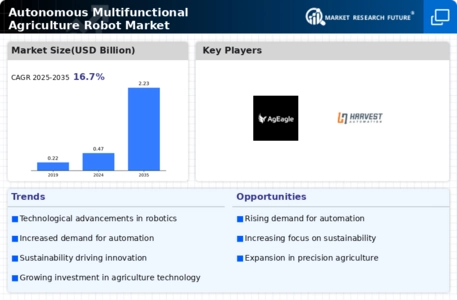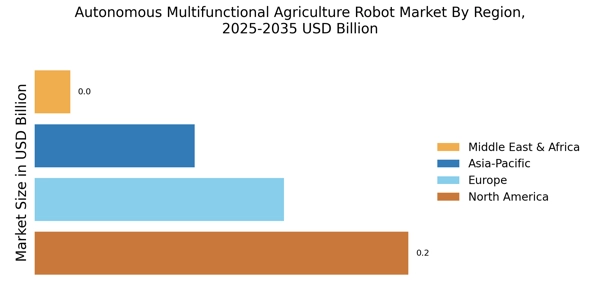Rising Labor Costs
The Autonomous Multifunctional Agriculture Robot Market is experiencing a notable surge due to the increasing labor costs associated with traditional farming practices. As wages for agricultural workers rise, farmers are compelled to seek cost-effective alternatives. Autonomous robots offer a solution by performing tasks such as planting, harvesting, and monitoring crops with minimal human intervention. This shift not only reduces labor expenses but also enhances operational efficiency. According to recent data, labor costs in agriculture have escalated by approximately 20% over the past five years, prompting a significant interest in automation. Consequently, the demand for autonomous multifunctional agriculture robots is likely to grow, as they provide a viable means to mitigate rising labor expenses while maintaining productivity.
Technological Advancements
Technological advancements play a pivotal role in shaping the Autonomous Multifunctional Agriculture Robot Market. Innovations in robotics, sensors, and artificial intelligence have led to the development of highly sophisticated agricultural robots capable of performing a variety of tasks. These robots can analyze soil conditions, monitor crop health, and optimize resource usage, thereby enhancing overall farm productivity. The integration of advanced technologies has resulted in a projected market growth rate of 15% annually over the next five years. As farmers increasingly recognize the benefits of these technologies, the demand for multifunctional robots is expected to rise, further driving the market forward. The continuous evolution of technology in agriculture suggests a promising future for autonomous solutions.
Growing Demand for Food Security
The Autonomous Multifunctional Agriculture Robot Market is significantly influenced by the growing demand for food security. As the global population continues to expand, the pressure on agricultural systems to produce sufficient food increases. Autonomous robots can address this challenge by enhancing crop yields and ensuring efficient resource management. With projections indicating that food production must increase by 70% by 2050 to meet global needs, the role of automation becomes increasingly critical. Farmers are turning to multifunctional robots to maximize output while minimizing environmental impact. This trend is likely to propel the market forward, as stakeholders seek innovative solutions to ensure food security in an ever-changing landscape.
Environmental Sustainability Goals
The Autonomous Multifunctional Agriculture Robot Market is increasingly driven by the need for environmental sustainability. As concerns about climate change and resource depletion grow, there is a pressing need for agricultural practices that minimize environmental impact. Autonomous robots can contribute to sustainable farming by optimizing resource use, reducing chemical inputs, and enhancing soil health. For example, precision application of fertilizers and pesticides by robots can lead to a significant reduction in chemical runoff. This aligns with the sustainability goals set by various international agreements, which aim to promote eco-friendly agricultural practices. As farmers strive to meet these goals, the demand for multifunctional robots that support sustainable agriculture is likely to increase, shaping the future of the industry.
Government Support and Initiatives
Government support and initiatives are emerging as a crucial driver for the Autonomous Multifunctional Agriculture Robot Market. Various governments are recognizing the potential of automation in agriculture and are implementing policies to promote the adoption of advanced technologies. Financial incentives, grants, and research funding are being allocated to encourage farmers to invest in autonomous solutions. For instance, several countries have introduced subsidies for purchasing agricultural robots, which can significantly reduce the initial investment burden. This supportive environment is likely to foster innovation and accelerate the growth of the market. As more farmers take advantage of these initiatives, the demand for multifunctional robots is expected to rise, further solidifying their role in modern agriculture.

















Leave a Comment